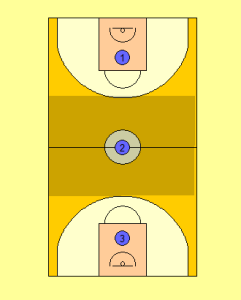Full Court Press: Strategy of the Secondary Trap
When implementing a Full Court Press, after the initial stages of how the trapping action happens attention should then shift to the options for a Secondary Trap. The Secondary Trap is the name given to those options for another trap to form after the first has broken down or been released. A team that discusses the secondary trap and works to perfect this action is a team that is twice as hard to beat. A secondary trap can be executed in the full court, half court or quarter court depending on a team’s defensive strategy.
Thinking about a secondary trap is not necessarily discussing what happens when a press breaks down. Just because the ball is moved out of the initial trapping situation does not mean that the defence has failed. In some instances, the secondary trap might be the intended phase within a trapping defence that a team wants so they can pressure the ball more aggressively when possession is in certain players hands. For example, when facing a team that has a capable Point Guard, but very weak supporting ball handlers. The initial trapping situation might be used to move the ball out of the Point Guards hands and then apply extreme pressure the next receiver.
In the full court, the use of the secondary trap is all about using the court effectively. Making every inch of the floor valuable and a challenge for opposition teams to win. If a defensive team is not going to use a secondary trap, then maybe a half-court trap is a better option as this will not stretch the defence as much and also limit the focus to one trapping phase (which is often the focus of half court traps) can be more effective.
When supplementary trapping situations are focused upon within a team’s full court defence there can be opportunities explored even as the ball is advanced deep down the court to the basket. As mentioned previously there is no reason that up to three trapping areas cannot be explored and drilled by a team. These areas are marked in the Diagram below as Areas 1, 2 and 3.

Alternatively, a different approach can be taken and in different areas of the court, different trapping strategies are applied so an opposition’s offense is unable to become comfortable with the tactics they are facing. For example in Area 1, a team may not want to trap, but simply slow the progress of the ball and stall an effective opposition’s transition offense. In Area 2 a team might decide Hedge and Recover so to the offense the trap looks like it is about to happen and so the ball is continued to be rotated away from the key ball handlers and into the weaker decision makers hands within the group before trapping aggressively in Area 3.
If facing a team with a very effective Press Breaker one option is to reduce the press formation to the ¾ court. Then not trap in Areas 1 or 2. This will space the offense out and condense the defence . Then providing all defenders are active a secondary trap can be triggered in Area 3. If executed well, many off the offensive players can be still in the back court when the trap happens and not able to initially take part as a pressure release target for the ball handler.
All of the examples above make the secondary trap a very useful strategy in not only providing depth to a team’s defence, but also being flexible in tactics to compete an ultimately win a game. A good secondary trap is a trap that exposes a team, a does just not focus on the key ball handler of the opposition. When that happens a defence is starting ask questions of players who do not normally make decision at pace, on the dribble or in traffic and that can only be a good thing for the defence.








Leave a Reply